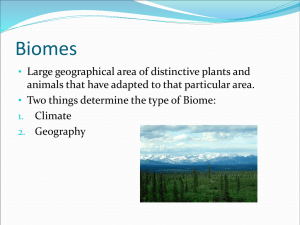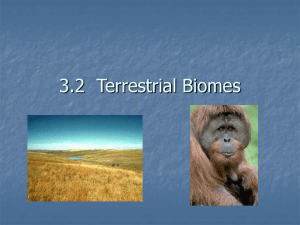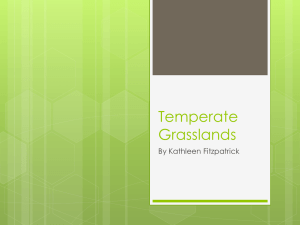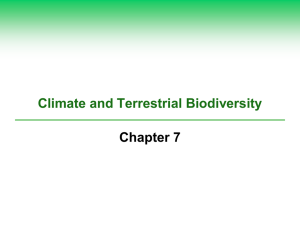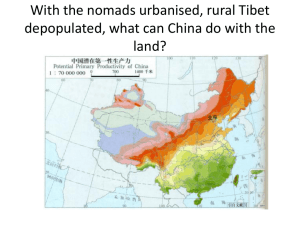What is a Biome - Auburn City Schools
advertisement
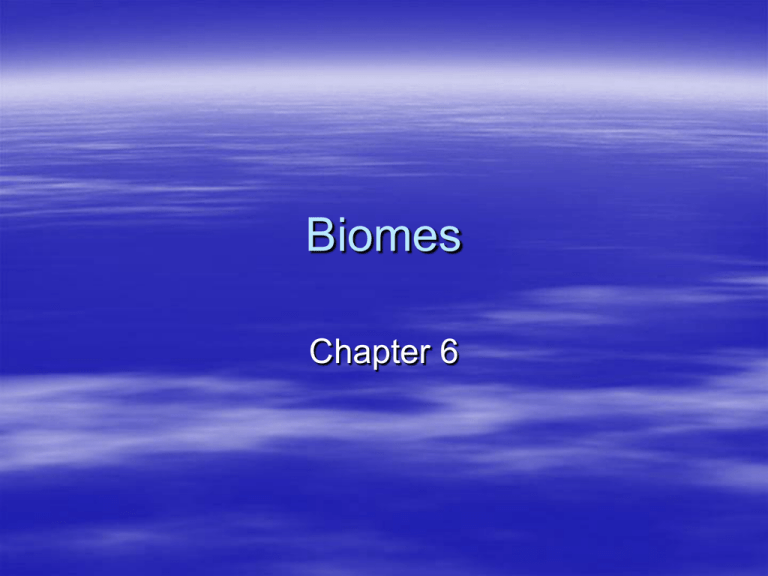
Biomes Chapter 6 What is a biome? Biome- large region characterized by a specific type of climate and certain types of organisms. Biomes and Vegetation Biomes are described by their vegetation because plant species will determine the animal species in an area. – Plants in a biome have adaptations that allow them to survive the climate conditions for that biome. Ex- size, shape, color, root depth, reproductive strategy Biomes and Climate Climate- weather conditions – Climate determines plants – Two most important factors: Temperature- most organisms are adapted to live in a range of temperatures. If the temperature get out of the desired range the organism my die. Precipitation-The larger the organism the more water is needed for growth and survival. Biomes and Climate Biomes and Climate Latitude- distance north or south from the equator. Altitude- the height of an object above seas level. Forest Biomes Forest Biomes Tropical Rain Forest – Location- around the world near the equator Forest Biomes Tropical Rainforest – Precipitation- 200-450 cm per year – Temperature- very warm – Growing season- 12 months – Soil- Poor quality Leeching washes away nutrients Plants adapted with buttresses to support the tall trees with shallow root systems. Forest Biomes Tropical Rainforest – Species diversity- greatest amount of diversity One hectare of land may contain 100 species of trees (compared to only a few species in a temperate forest.) Insects, amphibians, reptiles, mammals, birds – Threats- Logging and clearing for farm land 7% of earth’s surface (compared to 20% in the past) Everyday about 100 acres lost Forest Biomes Temperate Rainforest – Location- North America, Australia and New Zealand. – Precipitation- 200-450 cm per year – Temperature- Moderate Temperatures – Growing season- 9-12 months since it rarely gets below freezing. – Soil- Nutrient Rich Forest Biomes Temperate Deciduous Forest – Location- between 30 and 50 N Forest Biomes Temperate Deciduous Forest – Precipitation- 75-125 cm per year – Temperature- Warm to hot summers and cool to cold winters – Growing season- 4-6 months – Soil- Deep rich soil due to dropping of leaves in the autumn. Forest Biomes Temperate Deciduous Forest – Species diversity- Good Species Diversity Insects, mammals, birds Amphibians and reptiles in warmer forest – Threats- Logging and clearing for farm land and urbanization Forest land has increased as farm land has been abandoned in the U.S. and other countries. Today more forest exist in Alabama than in 1900. Forest Biomes Taiga (Northern Coniferous Forest or Boreal Forest) – Location- around 50 N Forest Biomes Taiga – Precipitation- around 50 cm per year – Temperature- Warm summers and cold harsh winters – Growing season- 50 days to 6 months – Soil- poor quality- very acidic Forest Biomes Taiga – Species diversity- Low Species Diversity Insects, mammals, birds Plants dominated by conifers – Threats- Acid rain, disease, and logging Low species diversity allows disease to decimate a forest. Grasslands Savanna – Location- near equator Grasslands Savannas – Precipitation- 50 – 125 cm per year Wet and dry season – Temperature- 25- 30 C – Growing season- during the wet season – Soil- Rich in moist areas and poor in very dry regions Grasslands Savanna – Species Diversity- relatively diverse (less than rain and deciduous forest) Plant adaptations- runners, vertical leaves, thorns, drop leaves during the dry season Insects, mammals, birds Large migratory grazing herbivores are dominant on the landscape. Grasslands Temperate Grassland – Location- around 30 N & S latitude American Prairie, Russian Steppes, Veldt of South Africa, and Pampas of South America Grasslands Temperate Grasslands – Precipitation- 25-75 cm per year – Temperature- Hot summers and cold winters – Growing season- During the warm summer months (latitude will determine the length of summer) – Soil- Rich Soil Grasslands Temperate Grasslands – Species Diversity- moderately diverse Plants– dense sod forming grasses or bunch grasses – Grasses survive frequent fire Animals– Insects, mammals, birds, reptiles – Large migratory grazing animals – Burrowing mammals Grasslands Temperate Grassland Grasslands Chaparral- Temperate woodland with scattered tree communities. – Location- Temperate zone near coastal areas Grasslands Chaparral – Precipitation- around 3035 cm per year Dry summers and wet winters – Temperature- warm summers and mild winters – Growing season- year around – Soil- poor Grasslands Chaparral – Species Diversity Plants– low-lying, evergreen shrubs and trees – Leathery leaves retain water – Adapted to fire Animals – camouflage – Threats Human development Desert High Desert – Location- 30- 60 N & S latitude Hot Desert – Location- 0- 30 N & S latitude Desert Desert Desert – Precipitation- less than 25 cm per year – Temperature- varies (hot days/cold nights) – Growing seasonshortly after rain – Soil- poor (very little humus) Desert Species Diversity- Very Low – Plant adaptations Succulents- thick, fleshy stems and leaves that hold water. Shallow spreading root system Short quick growth cycle when rain is available – Animal adaptations Thick scaly skin holds water Estivating- burrowing during the hottest part of the day Nocturnal Reptiles, Mammals, Birds, insects – Threats- species loss, the amount of desert is increasing word wide. Tundra Location – Northern polar regions (above 60 N latitude) Tundra Precipitation- Less that 25 cm per year (snow) Temperature- long cold harsh winters and short mild summers Growing seasonsummer (4 months or less) Soil- Poor (permafrost) Tundra Species Diversity- very low – Plant adaptations Low growing Shallow roots systems Quick reproductive cycle – Animal adaptations Migrate or burrow during winter Mammals, birds (summer), insects (summer) – Threats Habitat loss and pollution Tundra Tundra


